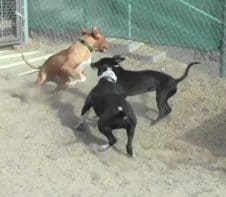In speaking with people having a wide variety of approaches to dog training, it’s been a bit curious to note which groups seemed to know the most about their own approach, which ones were the more open-minded, and who would willingly and knowledgeably discuss alternatives. I’ll discuss a few specific types and the extremes here.
The Shock Collar People
As in all approaches, here there are some people who have little idea of what they’re doing. They just focus on a very few things that they’ve found seem to work for them, and I’ll skip over them.
However, there are those who use this effectively and sparingly. Some use the newer versions of shock collars, which focus mostly on just gaining the dog’s attention. They may include other variations with noise or vibration.
Most of them also use a variety of other approaches and are just fine in discussing training methods. Provided, of course, you don’t just stand there and yell at them about the shock collars. They seem aware of all the dangers that other groups bring out, but also know that they are dependent on a number of factors, and can be avoided. I don’t use those collars or see them as necessary for any training that I do, but you can at least talk with those people.
The Punishment People
They make no bones about it. Punishment and discipline are the only ways to get the behavior they want. At the park, I was listening to a cop with a young Great Dane explain this to a guy whose Chihuahua wouldn’t stop pulling on the leash. He talked about how the K9 officer showed him that you have to hit the dog hard enough to make sure that he listens to you. For these people, their only claim is that it works for them, and that’s all they care about.
There’s nothing more that you can do here unless they fail badly enough and come asking for help, but more often the dog will be put down if their method fails.
The Positive-Only People
I’ll group these with their extreme relations, the Force-Free/Positive-Only people. The simple Positive-Only people are nearly as bad, as they seem to know only some techniques they were told to use, but have no comprehension of the limitations of positive reinforcement. And we might pretty much put most Clicker Trainers in this same slot, as I’ve sadly never found one who could clear elucidate the limitations of clicker training.
Actually, some clicker trainers who are teaching complex behaviors to already trained dogs do seem to have a reasonable grasp of those techniques. But the ones trying to work with scared and aggressive dogs are often clueless. I’ve had them sputtering and walking away when I describe some aspects of their training as too aversive for my tastes.
They seem to focus on two main arguments. First, claiming all that they do is based on well-established science. Next, that this is endorsed by well-known experts in the field. But, every time I try to refer to details in actual textbooks and research papers, they either cherry-pick their conclusions or simply ignore them and claim their experts are better.
Comes the Converts
In this group, we may also find the Positive-Only/Converts. Those who had started with dominance and punishment, but who later saw the light. They feel that they have learned so very much, and you can be a better person by following them.
Now, why is it all these converts are so strongly attached and convinced in what they do?
A Basis for Denial
Have you ever noticed that many of the people who convert to a different religion will often become stricter adherents than those born into that religion? I suspect that the same thing applies in dog training, with those who move from punishment and discipline-based methods to positive reinforcement. Here, we visit EileenAndDogs, a popular and long-running blog on dog behavior by Eileen Anderson, and look at some of her views on Being Open-Minded About Training.

Just how is this an ultimate irony? When I first started working with dogs my methods were quite different than they are now. I didn’t understand the ethology or even their body language, and some forceful methods later changed to soft words and touches. However, nowhere along this long path was any of my effort Herculean in scope or intensity. About the only ways I could see that happening would be if the person started from being very close-minded, narrowly educated, and strongly invested in her current views, or feeling guilty about past mistakes.
And, if that were the case, wouldn’t we expect that their new, present views would now be defended in the same close-minded manner? Over the years I’ve run into people using about the whole range of dog training approaches. And those converts seem among the most close-minded.
As it isn’t possible to teach somebody months or years of education in minutes, I usually offered demonstrations where I’ve elicited behaviors from dogs that they could not produce. I’ve even worked effectively with dogs that they could not even approach. However, they will not change their views. Nor will they even recognize specific actions they are taking that are counter-productive or aversive to the dog. Not even if the dog’s behaviors clearly point this out. A common example of this is detailed in desensitization.
Putting it in perspective, none of these people are that bad. And most dog issues are quite simple, so they are able to help many dogs. But for those dogs who need more help, it either takes a very long time or never really gets there.
The Clicking Experts
While Lost Pets New Mexico is a very nice group that helps in finding many dogs, they occasionally just pass on some advice from people they believe to be knowledgeable in dog behavior and training. However, sometimes they really pick the wrong one.

At first glance, their argument might seem fairly strong. After all, this comes from a place called Clicker Solutions, which does World Class dog training, and the owner is a CPDT-KA. That’s a certified dog trainer, and the KA at the end means knowledge assessed, so they had to pass a test!
They say no force, pain, or intimidation. Well, that all sounds fine. But then they claim to have no verbal corrections. So, if the dog does something wrong, you write her a note? Yes, it’s difficult to avoid sarcasm when people make such claims. Perhaps they only mean no screaming at the dog, but that is never said, and verbal corrections are normally an integral part of communicating with any dog. Without any qualification or clarification, it becomes an argument in extremes, also known as an appeal to extremes that’s used mainly for its impact in sound bites.
Now, let’s look at their “What if…” in the picture. The 1st item comparing to people scared of spiders would only apply to a dog who is already scared of the squirt bottle. I ran shelter playgroups for years with thousands of dogs and never saw a single one scared of the squirt bottle.
Yes, a dog who is generally very anxious might be, but they are also scared of most other things in the world. Those dogs would never be brought into a general playgroup. And behavioral rehabilitation methods would be used with them, instead of normal training methods, so they would never see a squirt bottle.
For their 2nd item, every time the dog does something wrong, they claim the dogs are sprayed in the face. Now, that’s really an appeal to extremes. There’s actually one local dog trainer who will hang the dog in the air by their leash if they are stubborn. Using Clicker Solutions logic, that means nobody should ever use a leash with a dog because it could be used to hang them?
To promote an appeal to extremes, one must think of the worst example and promote that as though it were the common usage. If the only thing Clicker Solutions knows to do with a squirt bottle is to squirt the dog in her face, they are sadly ignorant. Now let’s talk instead of why and how the squirt bottle could be used.
The Badge Protocol
The primary use for squirt bottles in training dogs is for those dogs who have been taught (or otherwise learned) to ignore human verbal commands and gestures. In that use, the water squirt bottle can be directed to a specific dog from a little distance and includes no noise or other activity that might disturb nearby dogs. In regular training, the squirt bottle is also phased out in a few days, as no longer needed.
It is also used for excited dogs in a group or playgroup, where they have not learned sufficient commands and impulse control to respond to you, but where an unusual interruption gives them pause. Many of these are often strange dogs in their first playgroup. Where a fight is about to start, the dogs often won’t hear your commands, but a water squirt between the two dogs interrupts their activity for just an instant, giving you a chance to start managing them. There are other methods used in playgroups, such as noisy shake cans and air horns, but this is more directed without disturbing the other dogs. While the dog may not like it, it’s surely less likely to cause harm than even items such as a leash.

This is sometimes called a Badge Protocol. Because a badge is not something that most people would often see, they will often quickly respond to it. Similarly, some dogs may ignore any shouting or hand waving but will respond to something unusual. The squirt bottle is perhaps the most narrowly directed and least likely to harm or panic a dog of anything one can think of. Sure, you could always walk up and tap him on the shoulder, after you manage to run and catch him, disturbing all the other dogs around.

Here’s an example I’ve demonstrated several times at shelter dog playgroups. We would often have one dog who would mount another dog, who did not like it but didn’t know how to deal with him. And this type of issue tends to repeat for a time. The first time, the dog was directly squirted, while also pointing at him and using his name while telling him to get down. The next few times, the squirt was just in front of him. Then with the pointing and verbal command, I would simply hold up the squirt bottle for him to see. Soon after, the squirt bottle was no longer needed, and the dog was now starting to respond when caught before he even jumped up. Next, you’ll see the Positive Dog Trainer alternative to this.
The Visiting Expert
In the shelter dog playgroups I just mentioned, one day I had a CPDT-KA Dog Trainer come in. In a discussion, she insisted that my squirt bottle was simply too aversive and that I should use more scientific and professional methods with the dogs. As often happens, one guy started mounting another dog, and I asked her to show me how she would handle this.


Sarah then walks over to the offending dog, grabs his collar, and forcefully yanks him off the other dog. Then just walks away. A few minutes later it repeats, and again she yanks the dog off. In a brief discussion, she insists this is less aversive than my water squirt bottle.
I am sure (or, at least I hope) that somewhere out there are dog trainers who are a little more capable than Sarah was, wherever it is that they are hiding. She then went on to become the Behavior Manager for a large municipal animal shelter, at which point most of the playgroups were stopped.
